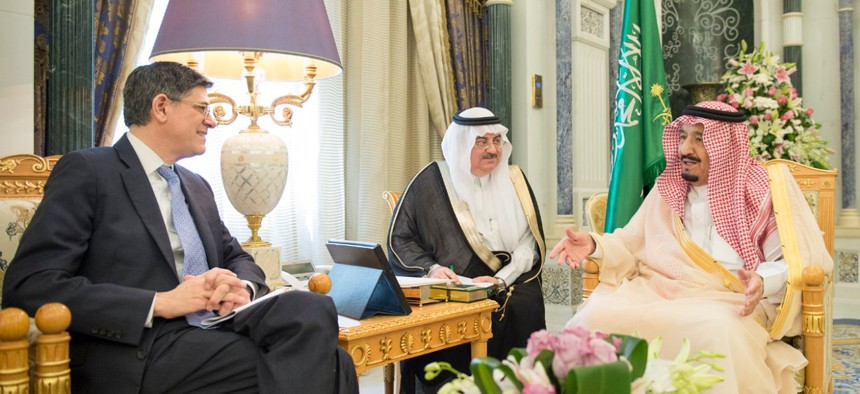
Saudi Arabian king Salman bin Abdulaziz Al Saud receives U.S. Treasury officials. Saudi Press Agency
Saudi Arabia: A Kingdom Coming Undone
As Riyadh embarks on a rocky journey to economic diversification, the U.S. should offer help — but not unconditionally.
Though some find reason for optimism in Saudi Arabia’s National Transformation Plan, the roadmap to economic diversification released earlier this year, there is little realistic prospect for a smooth transition. The very push toward reform, while noble and necessary, could propel Saudi Arabia toward political instability. Recognizing this, the United States should encourage Riyadh by offering high-level coordination and technical expertise but not unconditional support even as the Kingdom struggles.
Far from “a revolution here disguised as economic reform,” as some have called it, the situation is more simply described as a series of choices, ranging from risky to dangerous, that are being forced upon the Saudi government by a lack of planning when the Kingdom was flush with cash, a social contract underwritten by welfare spending, and a foolish faith that high oil prices would persist.
Saudi Arabia is embarking on its economic transformation under two principal budgetary burdens: demographic change and collapsed oil prices.
First, the Saudi adult population will more than double in the next fifteen years, driving subsidies and other government payments to unsustainable levels. The creation of private-sector jobs is the obvious answer for a country whose government employs 70 percent of its working citizens, but the sheer numbers show the difficulty. Executing the National Transformation Plan would require the creation of six million new jobs by 2030 — more if women enter the workforce in larger numbers — and yet the 2003-13 oil boom created just one-third that many. The Kingdom’s currently aims to create 450,000 non-oil jobs before 2020, and yet it would need to create 226,000 jobs a year just to accommodate new entrants to the labor market.
In the meantime, declining global energy prices are draining funds for reforms projected to cost an estimated 4 trillion dollars. Moreover, Saudis rely almost entirely on domestic diesel and natural gas for power; at current rates demand will cut two million barrels a day from exports by 2020 further paring cash to commit to reform
These pressures have already prompted several unprecedented moves, including the decision to float a partial initial public offering (IPO) of Saudi Aramco and the effort to eliminate fossil fuel subsidies. Deputy Crown Prince Mohammad bin Salman introduced the IPO as an incentive for transparency and counter to corruption.
Yet transparency might also bring instability. Saudi Arabia, more so than any other OPEC monarchy or Gulf Arab autocracy, maintains an expansive and intricate network of royal family members, many of whom play an active role in shaping the country’s political direction.
Related: The US Should Stand with Saudi Arabia in Yemen
Related: Start Preparing for the Collapse of the Saudi Kingdom
Related: Swooning for Saudi Arabia
Oil profits have long bought compliance from Saudi Arabia’s expansive and intricate network of royal family members, and shedding light on Saudi Aramco’s books endangers that long-standing bargain. Already, senior princes have allegedly called for regime change, expressing extreme distaste for the country’s new direction and the deputy crown prince himself.
On the other side of the political spectrum, plans to remove subsidies and reduce public spending invites the prospect of widespread social unrest. Saudi Arabia likely sidestepped the wave of unrest in 2011 only because of its generous oil-financed welfare system, but earlier this year, Saudi construction workers who had not received wages in months torched buses in Mecca, demonstrating that the conditions that produced the Arab Spring remain a looming concern. Assuming cuts without consequence will propagate poor policy and has a poor track record.
It is overly optimistic to assume that Saudi Arabia has the resources, the urgency, and the talent needed to swiftly push into a post-oil future. Nor can foreign investment be counted upon to pour into the country, creating the millions of jobs necessary.
More likely, the Kingdom will find the road ahead enormously difficult. Destabilization could take several forms; among them, bloody power struggles within the ranks of royal family or violent political unrest echoing the Arab Spring.
This is not to say the United States should back away from its commitment to Saudi Arabia. Instead, the next administration should act to mitigate these possibilities. First, it should prioritize economic issues at the highest level between U.S. and Saudi officials. To advance climate action, President Obama required all bilateral meetings to raise the issue, prompting world leaders to raise it in advance. A similar principle should apply here.
Second, the next president should make clear that the United States will not pursue investments in the Kingdom that intermingle the American economy with theirs. U.S. policy should not provide Saudi leadership with a false sense of implicit U.S. backing.
However, U.S. officials can encourage Saudi efforts by offering technical expertise. The United States could help the Kingdom design programs linking reform to assistance for poorer Saudis to avoid unrest. Saudi Arabia should not rely exclusively on consultancies as it charts a new, decades-long course.
The path forward on Saudi Arabia is not a binary choice between greater support and complete disengagement. There is a middle path, where U.S. officials can advise and assist where possible and prepare for trouble where it is likely.
NEXT STORY: The Shia Power Brokers of the New Iraq



